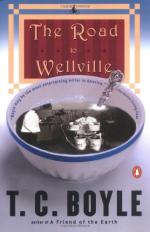|
This section contains 3,218 words (approx. 11 pages at 300 words per page) |

|
SOURCE: "Survival of the Cruelest," in The New Republic, Vol. 209, No. 14, October 4, 1993, pp. 43-5.
In the following review of The Road to Wellville, Seligman surveys Boyle's career, contending that the novelist's "pyrotechnical exhibitionism" fails to conceal the "black-hearted fatalism" that ultimately renders all his works simplistic.
A sanitarium is a funny place to set a novel if you don't believe in cures. But the Battle Creek Sanitarium, temple to healthy vegetarian living and stomping ground of Dr. John Harvey Kellogg (1852–1943), apostle of colonic hygiene and inventor of the cornflake, is where T. Coraghessan Boyle, a pessimist if there ever was one, has set The Road to Wellville, in the years 1907 and 1908. Boyle's pitiless and brilliant first novel, Water Music (1981), unfolds around the British exploration of the Niger circa 1800; World's End (1987) shifts back and forth between a Hudson River community in the seventeenth and twentieth centuries; and he has...
|
This section contains 3,218 words (approx. 11 pages at 300 words per page) |

|


